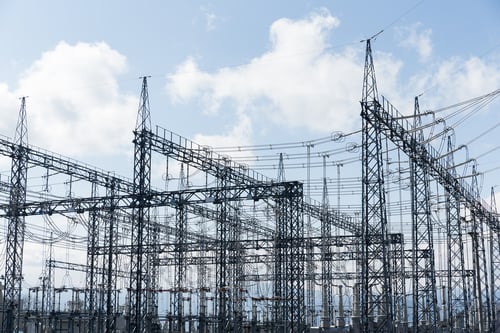Share this
Industrial Relay Selection Guide: How to Choose the Right Type
by Dawn Bertman on Mar 17, 2025 2:15:00 PM

Getting electrical current to behave just right isn’t always easy, but relays make it happen across all kinds of industrial equipment. These handy components keep things running smoothly in both simple and complex circuits.
Swapping out switches or high-amp wiring for relays – when it makes sense – can also free up space and cut costs.
Not every relay is built for the same job, though. The right pick depends on what it does best, where it falls short, and how well it fits your project.
This relay selection guide, part of our How to Source series, breaks down types of relays and what to look for when sourcing.
‘How to Source’ Series – Other Guides:
|
|
How to Source Every Electronic Component:
Types of Relays in Industrial Applications
Each electric or electrical project can require a different type of relay, contact configuration, and expectation for switching time. That’s why several categories of relays are prominent in the market.
Start your hunt by figuring out which relay type provides the best combination of these and other factors important to your assembly. The top three are:
Electromechanical Relays
These relays consist of a coil, electrical contacts, and an armature. They come with larger contact points and shorter mechanical lifetimes.
Electromechanical relays are the most popular choice for industrial applications, as long as they meet its requirements. Why? Simple – because the technology is old and doesn’t cost much. Due to the wide variety available, there’s almost certainly a type that’ll fit the system requirements for your project.
Reed Relays
These relays are built with coils surrounding two overlapping ferromagnetic blades (called reeds) that are sealed airtight in a capsule that holds inert gas. In contrast to an electromechanical relay, a reed relay has smaller physical contacts and a lower mass.
Reed relays switch more quickly and tend to offer a higher mechanical lifetime vs. electromechanical alternatives. However, these relays are prone to electrical damage from arcing when a circuit is closed.
Solid State Relays
These relays use an LED to actuate a photosensitive MOSFET (metal oxide silicon field effect transistor) for switching. These devices allow current to flow through when the LED actuates, making switching speed dependent on the time necessary to power the light on and off. At peak performance, SSRs operate at speeds even faster than those of reed relays.
SSRs are susceptible to damage and surge currents, similarly to reed versions.
Relay Selection Guide | Top 8 Considerations
Knowing how to select a relay is a straightforward path to better device performance and reliability. Considerations extend beyond the relay’s basic functionality. Both the physical and electrical matter, and that goes for the relay and its surrounding environment.
There are 8 primary considerations when selecting a relay:
- Size
- Switching speed & frequency
- Mechanical durability
- Surge current durability
- Voltage rating
- Operating environment
- Isolation between control & load circuits
- Multiple contacts
1. Size
Space constraints in the device can influence the type of industrial relay you use.
Now is the time to evaluate the mounting style and size of the relay. Choose the one that most accurately fits the space available (i.e. a PCB mount or DIN rail mount) as well as any unique mounting scenarios.
Beware that the more space a component takes up, the more it brings the heat. Smaller relays are best when you want to limit heat buildup in miniature assemblies and densely packed locations.
Be sure to balance dimensional constraints with the electrical requirements the relay must meet.
2. Switching Speed & Frequency
Different jobs require different switching speeds – a device that requires rapid response times or high-frequency operation has different needs than a low-impact device. In part because SSRs offer the fastest switching times, it’s common to find these relays in:
- Electrical control panels
- Medical equipment
- HVAC systems
Your options in relay selection are limited to whatever offers enough frequency to actually perform as advertised in your assembly.
3. Mechanical Durability
Relays have a finite number of operations they can perform before wearing out. This factors into future maintenance and downtime considerations. If continuous operation is critical to your product, make sure your components can withstand frequent switching.
SSRs are popular for their wear resistance – they don’t have any physical contacts to wear out in the first place. For electromechanical relays, you’ll have to weigh how many times the relay can switch before it’s no longer useful.
4. Surge Current Durability
Input surge current (aka inrush current) is the maximum amperage a relay contact can withstand at once for a specific load type. A component’s ability to handle brief overcurrents without sustaining damage is key to system reliability and durability.
To select a relay based on this criteria, compare the relay's maximum surge current rating with your application’s expected inrush current. Choose a relay that can handle the highest anticipated surge without damage, leaving a little margin for error just to be safe.
5. Voltage Rating
Rated voltage is a measure of how much electrical power a component is designed to handle. Understanding how to select a relay rating isn’t rocket science: It must be greater than or equal to the voltage driving the electrical load.
Most industrial-grade relays are available in 24-, 48-, 120-, and 240-volt variations. Often, the relay’s contact side has an entirely different voltage rating than the coil side. This is because it needs to switch and handle the load circuit, which can have different voltage requirements than the control circuit.
If low voltage is a requirement, a reed relay may be the best option. Since its contacts are sealed within glass, it’s a reliable long-term solution for switching at decent speeds with low power consumption.
6. Operating Environment
This time, knowing how to pick a relay is entirely on you. Where will the relay operate regularly? Review the assembly and its surrounding area for the presence of notable:
- Temperature
- Humidity
- Corrosive substances
- Vibration
Manufacturing and oil, gas, and mineral applications are most likely to cause trouble for relay performance. Know your application, and build the case for a specific relay from there.
| Also Thinking About Sensors? Environmental conditions don’t just affect relays – they matter for sensors too. If your build includes both, take a look at our Sensor Selection Guide: 12 Criteria for Industrial Electronics. It walks through what to look for when selecting sensors for industrial environments. |
7. Isolation Between Control & Load Circuits
Relays rule (most of) the switching world because they can isolate the power supply from the control circuit. The level to which your relay can do this is important if you need to protect sensitive control circuits from high voltages/currents on the load side. It’s also a means of adding safety on the human side.
To meet this relay selection guideline, the candidate in question needs enough dielectric strength and insulation to stop electrical interference or damage.
In many applications, the simple design of an electromechanical relay can still provide a nice level of isolation between control and load circuits. With no moving parts, modern SSRs are only coupled optically, and may offer even better isolation. The sealed nature of reed relays makes for similarly clean and reliable isolation for sensitive devices.
8. Multiple Contacts
The availability of multiple contacts is crucial when you need simultaneous control of several circuits or a specific sequence of operation. Relays with multiple contacts can manage these tasks efficiently within a single unit.
Distributing an electrical load across multiple touchpoints boosts the relay’s breaking capacity. By adding contacts in series, the relay can take on more demanding electrical duties.
Mechanical relays offer more configuration options for this multipoint format. SSRs tend to provide fewer contacts. Select a relay with the appropriate number and type of contacts (open, closed, or changeover) for your assembly’s level of complexity.
Relay Selection Guide: Cost & Supplier Factors
Reliability and safety aren’t just nice-to-have features in a relay – they’re non-negotiable, just like in your device. For industrial applications, a relay needs to respond precisely when it’s supposed to.
That’s why cost shouldn’t be the only deciding factor. Choosing the right fit for your assembly leads to better performance and long-term savings.
Before purchasing, take a close look at the manufacturer’s track record for quality and safety. Make sure their relays align with your application and operating environment based on the factors outlined above.
Your Go-To Guide for Sourcing Electronic Components
Looking for the best sourcing strategies? Download our guide for expert insights on managing supply chain disruptions and selecting reliable electronic components.
This article was originally published in January of 2024 and was recently updated to reflect current industry trends
Share this
- Components (39)
- Cost (29)
- Distribution (21)
- Materials (21)
- Cables & Wires (20)
- Supply Chain (19)
- Standards & Certifications (18)
- UL (17)
- Control Panels (16)
- Safety (14)
- Design (13)
- Contract Manufacturing (11)
- Inventory Management (11)
- News (10)
- Jacketing & Insulation (9)
- Suppliers (8)
- Wiring (8)
- Availability (7)
- Design & Engineering (7)
- Obsolescence Management (7)
- Testing & Prototyping (7)
- Maintenance & Downtime (6)
- Temperature & Fire Resistance (6)
- Enclosures (5)
- Manufacturing (5)
- Circuit Protection (4)
- Data Centers (4)
- Kitting & Fulfillment (4)
- Labeling (4)
- Sensors (4)
- Corrosion (3)
- Datacom (3)
- Cooling & Fans (2)
- Supplier Spotlight (2)
- Automation (1)
- Honeywell (1)
- PLCs (1)
- Relays (1)
- Security (1)
- November 2025 (1)
- October 2025 (1)
- August 2025 (1)
- July 2025 (6)
- June 2025 (4)
- May 2025 (4)
- April 2025 (3)
- March 2025 (11)
- February 2025 (3)
- January 2025 (2)
- December 2024 (1)
- November 2024 (1)
- October 2024 (1)
- September 2024 (3)
- August 2024 (1)
- July 2024 (4)
- June 2024 (3)
- April 2024 (2)
- March 2024 (1)
- January 2024 (1)
- October 2023 (1)
- June 2023 (1)
- May 2023 (1)
- April 2023 (1)
- March 2023 (2)
- October 2022 (1)
- March 2021 (3)





No Comments Yet
Let us know what you think